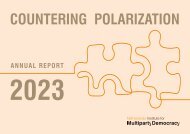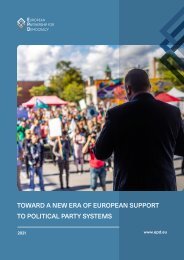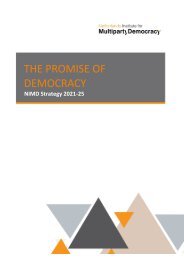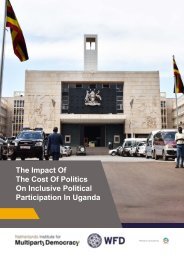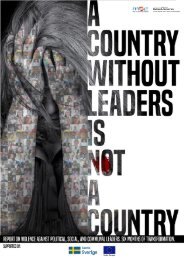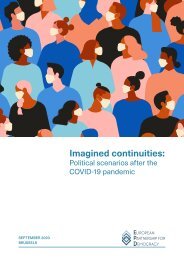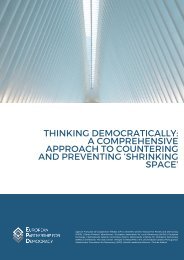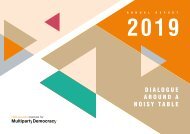Political Party Guidelines Eng
Create successful ePaper yourself
Turn your PDF publications into a flip-book with our unique Google optimized e-Paper software.
3.3 What does “gender mainstreaming” mean?
Mainstream, defined by a dictionary, means “that which is common; the norm”. So mainstreaming can
be seen as turning something to be the norm.
Gender mainstreaming is a concept promoted by many different organisations, and by the United
Nations already decades ago.
UN Women defines it:
“Gender mainstreaming is a globally accepted strategy for promoting gender equality. Mainstreaming is not
an end in itself but a strategy, an approach, a means to achieve the goal of gender equality. Mainstreaming
involves ensuring that gender perspectives and attention to the goal of gender equality are central to all
activities – policy development, research, advocacy/dialogue, legislation, resource allocation, and planning,
implementation and monitoring of programmes and projects.” 16
Example: FAO and Gender Mainstreaming
The Grameen Krishi (Agricultural) Foundation (GKF) was established in 1991 by the Grameen Bank in
Bangladesh. GKF supports agricultural development through irrigation, credit and services. The Foundation’s
gender strategy evolved over time. At first only men were included in GKF’s crop production activities,
while women were supported in their traditional homestead-based activities, such as rice processing and
small husbandry.
Gradually, GKF recognised women’s important and actual roles in crop production. This recognition, combined
with a serious commitment to women, led GKF to shift its gender strategy to one that involved women
farmers in irrigation and agricultural activities. Agricultural production became more accessible and
productive for women, who gained access to land, irrigation water, credit, seeds, fertilisers and marketing
facilities. Women were able to earn more income from agriculture than from their traditional activities. 17
Mainstreaming is not about adding on a “women’s component” or even a “gender equality
component”, to an existing activity. It involves more than increasing women’s participation.
Mainstreaming situates gender equality issues at the centre of policy decision, medium-term plans,
programme budgets, and institutional structures and processes. Mainstreaming entails bringing the
perceptions, experience, knowledge and interests of women as well as men to bear on policy-making,
planning and decision-making. Mainstreaming can reveal a need for changes in goals, strategies
and actions to ensure that both women and men can influence, participate in and benefit from
development processes. It can require changes in organisations – structures, procedures and cultures
– to create organisational environments which are conducive to the promotion of gender equality. 18
10
GUIDELINES FOR POLITICAL PARTIES IN MYANMAR




